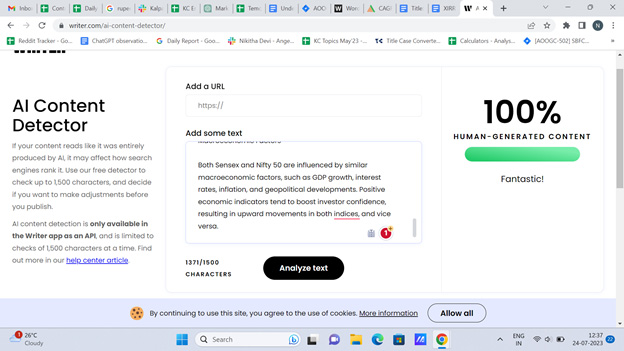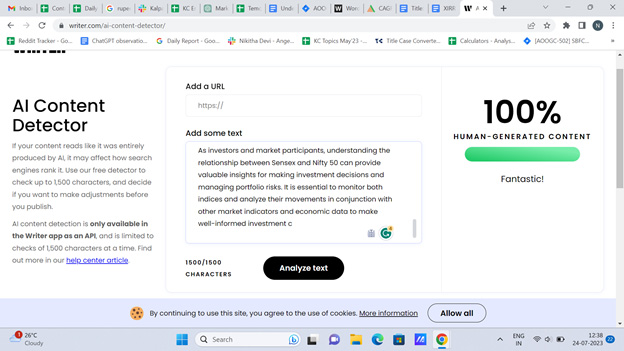The Nifty 50 and Sensex are two of the most prominent and widely followed stock market indices in India. They are barometers of the Indian stock market’s overall performance and represent the performance of the top 30 and top 50 companies (according to the market cap) listed on the Bombay Stock Exchange (BSE) and National Stock Exchange (NSE), respectively.
The relationship between Sensex and Nifty 50 is a crucial aspect of the Indian equity market, as it provides valuable insights into the market’s overall direction and sentiment. In this article, learn about the relationship between Sensex and Nifty 50, exploring their similarities, differences, and the factors that influence their movements.
Similarities and differences between Sensex and Nifty 50
1. Composition
The Nifty 50 and Sensex today represent the Indian stock market’s largest and most liquid companies. However, their composition differs significantly. The Sensex comprises the top 30 companies from various sectors, chosen based on market capitalisation. On the other hand, the Nifty 50 comprises the top 50 companies, ensuring a broader representation of the market. As a result, the Sensex is often considered a reflection of the performance of blue-chip companies, while the Nifty 50 provides a more diversified view of the market.
2. Representation
While both indices are widely followed, the Sensex often holds a more iconic status due to its longer history and higher media visibility. The Sensex, often referred to as the BSE index, is frequently mentioned in news reports, discussions, and investor sentiment analysis. However, the Nifty 50, or the NSE index, is gaining prominence, particularly among institutional investors and traders due to its broader representation and diversified sector exposure.
3. Calculation
The Sensex and Nifty 50 are calculated differently. The Sensex is a price-weighted index, meaning the stock prices of its constituent companies determine its value. In contrast, the Nifty 50 is a market capitalisation-weighted index, where the value of each company is proportional to its market capitalisation. The market capitalisation-weighted approach gives more weight to larger companies, reflecting their impact on the overall market performance.
Relationship and correlation of Sensex and Nifty 50
The Sensex and Nifty 50 generally exhibit a high degree of correlation due to their similar compositions and overlapping large-cap companies. A correlation coefficient measures the relationship between two indices, with values ranging from -1 to +1. A positive correlation, represented by a coefficient close to +1, indicates that the two indices tend to move in the same direction. On the other hand, a negative correlation, represented by a coefficient close to -1, means that the two indices move in opposite directions.
In the case of Sensex and Nifty 50, the correlation is typically positive and strong, often hovering around +0.90 to +0.95. This means that the two indices tend to move in tandem, reflecting the overall direction of the Indian equity market. When the market is bullish, both indices rise, and during bearish phases, they decline together. However, the magnitude of their movements may differ slightly due to their distinct calculation methodologies and composition.
Factors influencing the relationship between Sensex and Nifty 50
1. Large-cap dominance
Both indices have a significant representation of large-cap companies. As large-cap stocks tend to dominate the market’s overall movements, the correlation between Sensex and Nifty 50 is largely influenced by these common large-cap constituents.
2. Sectoral overlap
While the Sensex includes 30 companies, several of them are also part of the Nifty 50. As a result, sectoral movements in the market can impact both indices simultaneously, leading to a high correlation.
3. Macroeconomic factors
Both Sensex and Nifty 50 are influenced by similar macroeconomic factors, such as GDP growth, interest rates, inflation, and geopolitical developments. Positive economic indicators tend to boost investor confidence, resulting in upward movements in both indices and vice versa.
4. Foreign institutional investments
Foreign institutional investors (FIIs) are significant participants in the Indian equity market. Their buying and selling activity in large-cap companies affects both Sensex and Nifty 50, contributing to their high correlation.
5. Global market trends
Indian markets are not immune to global trends. International events, economic conditions, and geopolitical developments can impact investor sentiment, leading to synchronised movements in global indices, including the Sensex and Nifty 50.
Conclusion
The Sensex and Nifty 50 are both key barometers of the Indian stock market, representing the performance of top companies across various sectors. While they have some differences in their composition and calculation methodologies, they generally exhibit a strong positive correlation.
Both indices tend to move in tandem, reflecting the overall direction and sentiment of the Indian equity market. The high correlation between Sensex and Nifty 50 is influenced by factors such as large-cap dominance, sectoral overlap, macroeconomic conditions, foreign institutional investments, and global market trends.
As investors and market participants, understanding the relationship between Sensex and Nifty 50 can provide valuable insights for making investment decisions and managing portfolio risks. It is essential to monitor both indices and analyse their movements in conjunction with other market indicators and economic data to make well-informed investment choices in the dynamic and ever-changing Indian equity market.








































